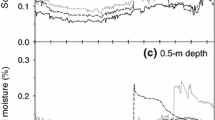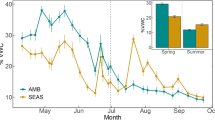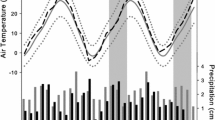Abstract
Productivity of aridland plants is predicted to increase substantially with rising atmospheric carbon dioxide (CO2) concentrations due to enhancement in plant water-use efficiency (WUE). However, to date, there are few detailed analyses of how intact desert vegetation responds to elevated CO2. From 1998 to 2001, we examined aboveground production, photosynthesis, and water relations within three species exposed to ambient (around 38 Pa) or elevated (55 Pa) CO2 concentrations at the Nevada Desert Free-Air CO2 Enrichment (FACE) Facility in southern Nevada, USA. The functional types sampled—evergreen (Larrea tridentata), drought-deciduous (Ambrosia dumosa), and winter-deciduous shrubs (Krameria erecta)—represent potentially different responses to elevated CO2 in this ecosystem. We found elevated CO2 significantly increased aboveground production in all three species during an anomalously wet year (1998), with relative production ratios (elevated:ambient CO2) ranging from 1.59 (Krameria) to 2.31 (Larrea). In three below-average rainfall years (1999–2001), growth was much reduced in all species, with only Ambrosia in 2001 having significantly higher production under elevated CO2. Integrated photosynthesis (mol CO2 m−2 y−1) in the three species was 1.26–2.03-fold higher under elevated CO2 in the wet year (1998) and 1.32–1.43-fold higher after the third year of reduced rainfall (2001). Instantaneous WUE was also higher in shrubs grown under elevated CO2. The timing of peak canopy development did not change under elevated CO2; for example, there was no observed extension of leaf longevity into the dry season in the deciduous species. Similarly, seasonal patterns in CO2 assimilation did not change, except for Larrea. Therefore, phenological and physiological patterns that characterize Mojave Desert perennials—early-season lags in canopy development behind peak photosynthetic capacity, coupled with reductions in late-season photosynthetic capacity prior to reductions in leaf area—were not significantly affected by elevated CO2. Together, these findings suggest that elevated CO2 can enhance the productivity of Mojave Desert shrubs, but this effect is most pronounced during years with abundant rainfall when soil resources are most available.



Similar content being viewed by others
References
Ackerman TL, Bamberg SA. 1974. Phenological studies in the Mojave Desert at Rock Valley (Nevada Test Site). In: Lieth H, Ed. Phenology and seasonality modeling, ecological studies; vol 8. Berlin Heidelberg New York: Springer. p 215–26
Allen-Diaz B, Chapin FS III, Diaz S, Howden M, Puigdefábregas J, Stafford-Smith M. 1996. Rangelands in a changing climate: impacts, adaptations and mitigation. In: Watson RT, Zinyowera MC, Moss RH, Dokken DJ, Eds. Contribution of Working Group II to the Second Assessment Report of the Intergovernmental Panel on Climate Change. New York: Cambridge University Press. p 131–58
Bazzaz FA. 1990. The response of natural ecosystems to rising global CO2 levels. Annu Rev Ecol Syst 21:167–96
Beatley JC. 1974. Phenological events and their environmental triggers in Mojave Desert ecosystems. Ecology 55:856–63
Belnap J. 1995. Surface disturbances: their role in accelerating desertification. Environ Monitor Assess 37:39–57
Billings SA, Schaeffer SM, Zitzer S, Charlet T, Smith SD, Evans RD. 2002. Alterations of nitrogen dynamics under elevated carbon dioxide in an intact Mojave Desert ecosystem: evidence from nitrogen-15 natural abundance. Oecologia 131:463–7
Bowes G. 1993. Facing the inevitable: plants and increasing atmospheric CO2. Annu Rev Plant Physiol Plant Molec Biol 44:309–32
Chew RM, Chew AE. 1965. The primary productivity of a desert shrub (Larrea tridentata) community. Ecol Monogr 35:355–75
Comstock JP, Ehleringer JR. 1986. Canopy dynamics and carbon gain in response to soil water availability in Encelia frutescens Gray, a drought-deciduous shrub. Oecologia 68:271–8
Comstock JP, Cooper TA, Ehleringer JR. 1988. Seasonal patterns of canopy development and carbon gain in 19 warm desert shrub species. Oecologia 75:327–335
Conroy JP. 1992. Influence of elevated atmospheric CO2 concentration on plant nutrition. Aust J Bot 40:445–56
Cunningham GL, Syvertsen JP, Reynolds JF, Willson JM. 1979. Some effects of soil-moisture availability on above-ground production and reproductive allocation in Larrea tridentata (DC) Cov. Oecologia 40:113–23
DeLucia EH, Hamilton JG, Naidu SL, Thomas RB, Andrews JA, Finzi A, Lavine M, et al. 1999. Net primary production of a forest ecosystem with experimental CO2 enrichment. Science 284:1177–9
Drake BG, González-Meler MA, Long SP. 1997. More efficient plants: a consequence of rising atmospheric CO2? Annu Rev Plant Physiol Plant Molec Biol 48:609–39
Drake BG, Peresta G, Beugeling E, Matamala R. 1996. Long-term elevated CO2 exposure in a Chesapeake Bay wetland: ecosystem gas exchange, primary production, and tissue nitrogen. In: Koch GW, Mooney HA, Eds. Carbon dioxide and terrestrial ecosystems. San Diego: Academic. p 197–214
Ehleringer JR. 2001. Productivity of deserts. In: Roy J, Saugier B, Mooney HA, Eds. Terrestrial global productivity. San Diego: Academic. p 345–62
Esler KJ, Rundel PW. 1999. Comparative patterns of phenology and growth form diversity in two winter rainfall deserts: the succulent Karoo and Mojave Desert ecosystems. Plant Ecol 142:97–104
Ettershank G, Ettershank J, Bryant M, Whitford WG. 1978. Effects of nitrogen on primary production in a Chihuahuan desert ecosystem. J Arid Environ 1:135–9
Fisher FM, Zak JC, Cunningham GL, Whitford WG. 1988. Water and nitrogen effects on growth and allocation patterns of creosotebush in the northern Chihuahuan Desert. J Range Manage 41:387–91
Hättenschwiler S, Miglietta F, Raschi A, Körner C. 1997. Thirty years of in situ tree growth under elevated CO2: a model for future forest responses? Global Change Biol 3:463–71
Hsiao TC. 1973. Plant responses to water stress. Annu Rev Plant Physiol 24:519–70
Huxman TE, Hamerlynck EP, Moore BD, Smith SD, Jordan DN, Zitzer SF, Nowak RS, et al. 1998. The photosynthetic down-regulation in Larrea tridentata exposed to elevated atmospheric CO2: interaction with drought under glasshouse and field (FACE) exposure. Plant Cell Environ 21:1153–61
Idso SB. 1999. The long-term response of trees to atmospheric CO2 enrichment. Global Change Biol 5:493–5
Jackson RB, Banner JL, Jobbagy EG, Pockman WT, Wall DH. 2002. Ecosystem carbon loss with woody plant invasion of grasslands. Nature 418:623–6
Jordan DN, Zitzer SF, Hendrey GR, Lewin KF, Nagy J, Nowak RS, Smith SD, et al. 1999. Biotic, abiotic and performance aspects of the Nevada Desert Free-Air CO2 Enrichment (FACE) Facility. Global Change Bioly 5:659–68
Kemp PR. 1983. Phenological patterns of Chihuahuan Desert plants in relation to the timing of water availability. J Ecol 71:427–36
Koch GW, Mooney HA. 1996. Response of terrestrial ecosystems to elevated CO2: a synthesis and summary. In: Koch GW, Mooney HA, Eds. Carbon dioxide and terrestrial ecosystems. San Diego: Academic. p 415–29
Lajtha K, Whitford WG. 1989. The effect of water and nitrogen amendments on photosynthesis, leaf demography, and resource-use efficiency in Larrea tridentata, a desert evergreen shrub. Oecologia 80:341–8
Loustau D, Hungate B, Drake BG. 2001. Water, nitrogen, rising atmospheric CO2, and terrestrial productivity. In: Roy J, Saugier B, Mooney HA, Eds. Terrestrial global productivity. San Diego: Academic. p 123–67
Melillo JM, McGuire AD, Kicklighter DW, Moore B, Vorosmarty CJ, Schloss AL. 1993. Global climate change and terrestrial net primary production. Nature 363:234–40
Mooney HA, Drake BG, Luxmoore RJ, Oechel WC, Pitelka LF. 1991. Predicting ecosystem response to elevated CO2 concentration. BioScience 41:96–104
Naumburg E, Housman DC, Huxman TE, Charlet TN, Loik ME, Smith SD. 2003. Photosynthetic responses of Mojave Desert shrubs to free air CO2 enrichment are greatest during wet years. Global Change Biol 9:276–85
Nilsen ET, Sharifi MR, Rundel PW, Virgina RA. 1986. Influences of microclimatic conditions and water relations on seasonal leaf dimorphism of Prosopis glandulosa var. torreyana in the Sonoran Desert, California. Oecologia 69:95–100
Noble IR, Gitay H, Alwelaie AN, Hoffman MT, Saunders AR. 1996. Deserts in a changing climate: impacts. In: Watson RT, Zinyowera MC, Moss RH, Dokken DJ, Eds. Contribution of Working Group II to the Second Assessment Report of the Intergovernmental Panel on Climate Change. New York: Cambridge University Press. p 159–69
Norby RJ, Hanson PJ, O’Neill EG, Tschaplinski TJ, Weltzin JF, Hansen RA, Cheng WS, et al. 2002. Net primary productivity of a CO2-enriched deciduous forest and the implications for carbon storage. Ecol Appl 12:1261–6
Nowak RS, DeFalco LA, Wilcox CS, Jordan DN, Coleman JS, Seemann JR, Smith SD. 2001. Leaf conductance decreased under free-air CO2 enrichment (FACE) for three perennials in the Nevada desert. New Phytol 150:449–58
Nowak RS, Ellsworth DS, Smith SD. 2004a. Tansley Review: functional responses of plants to elevated atmospheric CO2 — do photosynthetic and productivity data from FACE experiments support early predictions? New Phytol 162:253–80
Nowak RS, Zitzer SF, Babcock D, Smith-Longozo V, Charlet TN, Coleman JS, Seemann JR, others. 2004b. Elevated CO2 does not conserve soil moisture in the Mojave Desert. Ecology 85:93–9
Oechel WC, Vourlitis GL. 1996. Direct effects of elevated CO2 on arctic plant and ecosystem function. In: Koch GW, Mooney HA, Eds. Carbon dioxide and terrestrial ecosystems. San Diego: Academic. p 163–76
Orshan G. 1954. Surface reduction and its significance as a hydroecological factor. J Ecol 42:442–4
Owensby CE, Ham JM, Knapp AK, Rice CW, Coyne PI, Auen LM. 1996. Ecosystem-level responses of tallgrass prairie to elevated CO2. In: Koch GW, Mooney HA, Eds. Carbon dioxide and terrestrial ecosystems. San Diego: Academic. p 147–62
Pacala SW, Hurtt GC, Baker D, Peylin P, Houghton RA, Birdsey RA, Heath L, et al. 2001. Consistent land- and atmosphere-based U.S. carbon sink estimates. Science 292:2316–20.
Pataki DE, Huxman TE, Jordan DN, Zitzer SF, Coleman JS, Smith SD, Nowak RS, et al. 2000. Water use of two Mojave Desert shrubs under elevated CO2. Global Change Biol 6:889–97
Reynolds JF. 2001. Desertification. In: Levin S, Ed. Encyclopedia of biodiversity; vol 2. San Diego: Academic. p 61–78
Romney EM, Wallace A, Hunter RB. 1978. Plant response to nitrogen fertilization in the northern Mohave Desert and its relationship to water manipulation. In: West NE, Skujins J, Eds. Nitrogen in desert ecosystems. Stroudsburg (PA). Dowden, Hutchinson & Ross. p 232–43
Smith SD, Monson RK, Anderson JE. 1997. Physiological ecology of North American desert plants. Berlin Heidelberg New York: Springer
Smith SD, Huxman TE, Zitzer SF, Charlet TN, Housman DC, Coleman JS, Fenstermaker LK, others. 2000. Elevated CO2 increases productivity and invasive species success in an arid ecosystem. Nature 408:79–82
Sokal RR, Rohlf FJ. 1997. Biometry. New York: W.H. Freeman
Strain BR, Bazzaz FA. 1983. Terrestrial plant communities. In: Lemon E, Ed. CO2 and plants: the response of plants to rising levels of carbon dioxide. AAAS Select Symp 84. Washington (DC): American Association for the Advancement of Science. p 177–222.
Turner FB, Randall DC. 1987. The phenology of desert shrubs in southern Nevada. J Arid Environ 13:119–28
Webb WL, Lauenroth WK, Szarek SR, Kinerson RS. 1983. Primary production and abiotic controls in forests, grasslands, and desert ecosystems in the United States. Ecology 64:134–51
Weltzin JF, Loik ME, Schwinning S, Williams DG, Fay PA, Haddad BM, Harte J, et al. 2003. Assessing the response of terrestrial ecosystems to potential changes in precipitation. BioScience 53:941–52
Wong SC. 1979. Elevated atmospheric partial pressure of CO2 and plant growth. I. Interactions of nitrogen nutrition and photosynthetic capacity in C3 and C4 plants. Oecologia 44:68–74
Acknowledgments
We gratefully acknowledge support of the NDFF from the DOE Terrestrial Carbon Processes program (DE-FG03-00ER63049), Brookhaven National Laboratory, the DOE National Nuclear Security Administration/Nevada Operations Office, and Bechtel Nevada. This work was supported by National Science Foundation grants DEB-9814358 and DEB-0212812 to S. Smith and by additional support to R. Nowak from the Nevada Agricultural Experiment Station. The research was undertaken in partial fulfillment of the requirements for the Ph.D. degree in the Department of Biological Sciences at The University of Nevadas Las Vegas (D. Housa). We thank L. Fenstermaker, C. Grant, E. Knight, D. Monical, A. Ramos, J. Scherf, T. Shiver, D. Stortz-Lintz, J. Willinger, and L. Weiss for field and lab assistance. Comments by A. Austin and two anonymous reviewers greatly improved the manuscript.
Author information
Authors and Affiliations
Corresponding author
Rights and permissions
About this article
Cite this article
Housman, D.C., Naumburg, E., Huxman, T.E. et al. Increases in Desert Shrub Productivity under Elevated Carbon Dioxide Vary with Water Availability. Ecosystems 9, 374–385 (2006). https://doi.org/10.1007/s10021-005-0124-4
Received:
Accepted:
Published:
Issue Date:
DOI: https://doi.org/10.1007/s10021-005-0124-4




